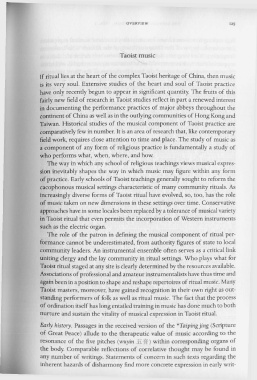Page 165 - The Encyclopedia of Taoism v1_A-L
P. 165
OVERVIEW 12 5
Taoist music
If ritual lies at the heart of the complex Taoist heritage of China, then music
is its very soul. Extensive studies of the heart and soul of Taoist practice
have only recently begun to appear in significant quantity. The fruits of this
fairly new field of research in Taoist studies reflect in part a renewed interest
in documenting the performance practices of major abbeys throughout the
continent of China as well as in the outlying communities of Hong Kong and
Taiwan. Historical studies of the musical component of Taoist practice are
comparatively few in number. It is an area of research that, like contemporary
field work, requires close attention to time and place. The study of music as
a component of any form of religious practice is fundamentally a study of
who performs what, when, where, and how.
The way in which any school of religious teachings views musical expres-
sion inevitably shapes the way in which music may figure within any form
of prac.tice. Early schools of Taoist teachings generally sought to reform the
cacophonous musical settings characteristic of many community rituals. As
increasingly diverse forms of Taoist ritual have evolved, so, too, has the role
of music taken on new dimensions in these settings over time. Conservative
approaches have in some locales been replaced by a tolerance of musical variety
in Taoist ritual that even permits the incorporation of Western instruments
such as the electric organ.
The role of the patron in defining the musical component of ritual per-
formance cannot be underestimated, from authority figures of state to local
community leaders. An instrumental ensemble often serves as a critical link
uniting clergy and the lay community in ritual settings. Who plays what for
Taoist ritual staged at any site is clearly determined by the resources available.
Associations of professional and amateur instrumentalists have thus time and
again been in a position to shape and reshape repertoires of ritual music. Many
Taoist masters, moreover, have gained recognition in their own right as out-
standing performers of folk as well as ritual music. The fact that the process
of ordination itself has long entailed training in music has done much to both
nurture and sustain the vitality of musical expression in Taoist ritual.
Early history. Passages in the received version of the * Taiping jing (Scripture
of Great Peace) allude to the therapeutic value of music according to the
resonance of the five pitches (wuyin 3i iff) within corresponding organs of
the body. Comparable reflections of correlative thought may be found in
any number of writings. Statements of concern in such texts regarding the
inherent hazards of disharmony find more concrete expression in early writ-

